Urban Ecology and Landscape Restoration
VerifiedAdded on 2020/03/16
|15
|3314
|45
AI Summary
This assignment delves into the multifaceted field of urban ecology, examining concepts such as novel ecosystems, human influences on landscapes, and the role of ecological restoration. It highlights the work of organizations like the Society for Ecological Restoration, drawing upon case studies like the Millennium Parklands and 'A Tale of Two Farms' to illustrate the challenges and opportunities presented by urbanization. The assignment also explores phytoremediation as a tool for mitigating environmental contamination in urban settings.
Contribute Materials
Your contribution can guide someone’s learning journey. Share your
documents today.
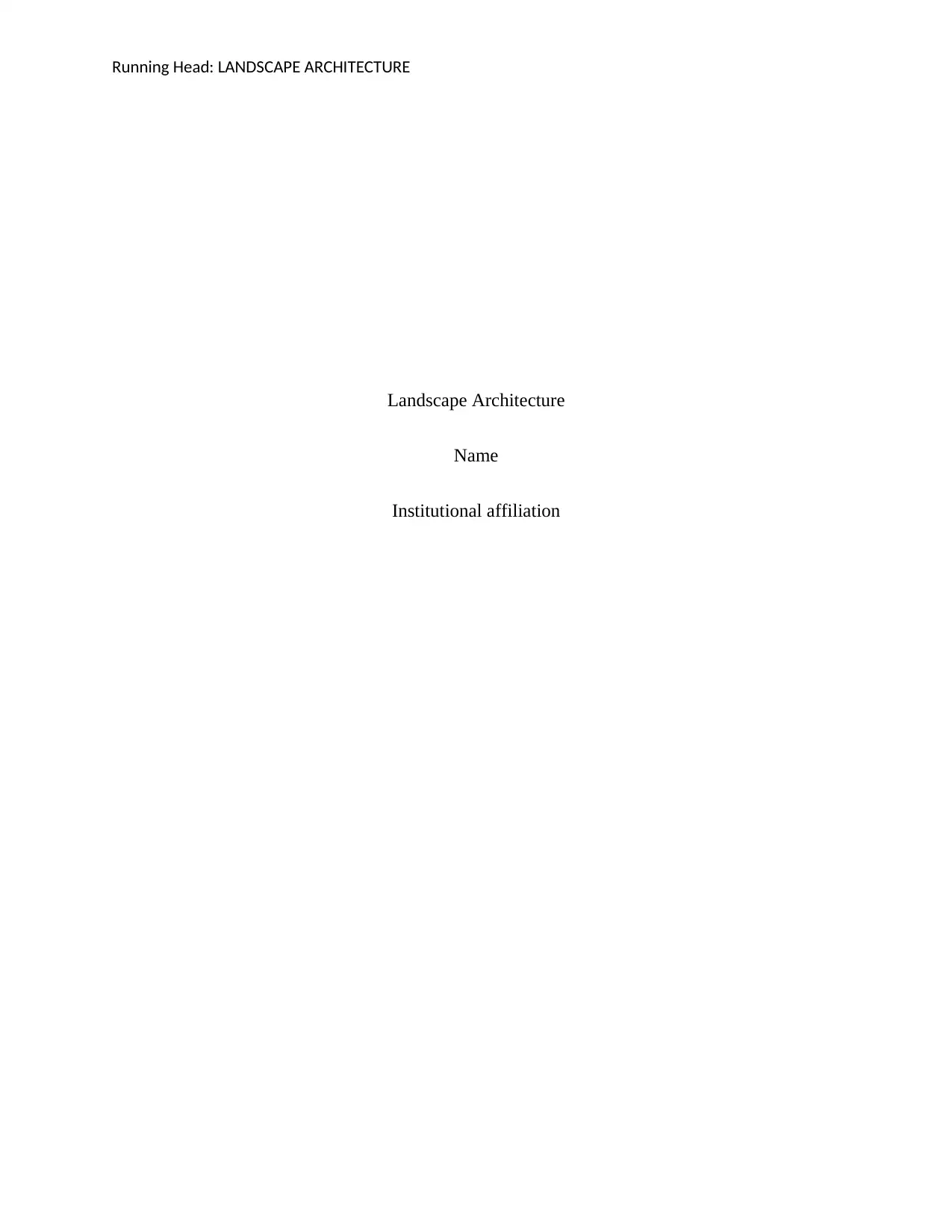
Running Head: LANDSCAPE ARCHITECTURE
Landscape Architecture
Name
Institutional affiliation
Landscape Architecture
Name
Institutional affiliation
Secure Best Marks with AI Grader
Need help grading? Try our AI Grader for instant feedback on your assignments.
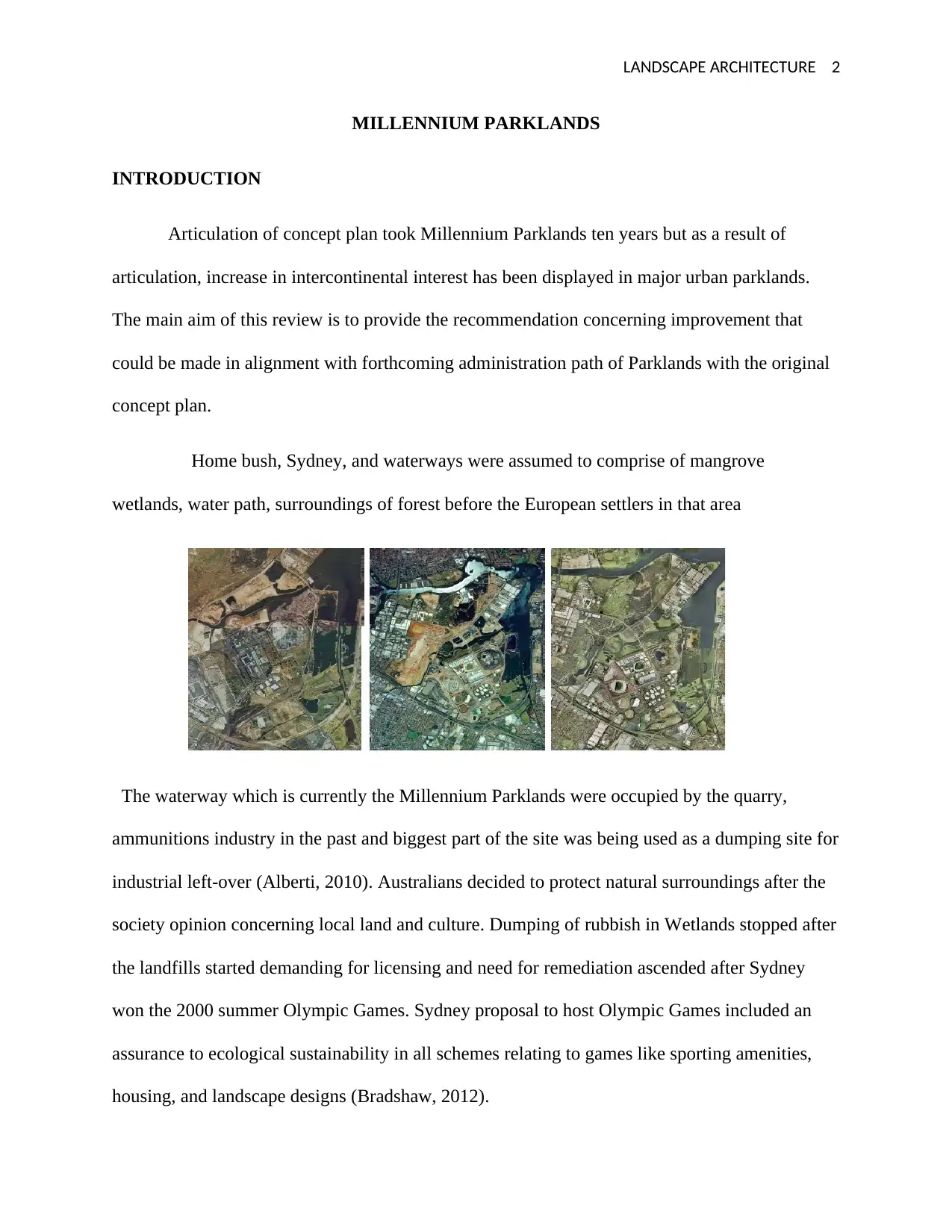
LANDSCAPE ARCHITECTURE 2
MILLENNIUM PARKLANDS
INTRODUCTION
Articulation of concept plan took Millennium Parklands ten years but as a result of
articulation, increase in intercontinental interest has been displayed in major urban parklands.
The main aim of this review is to provide the recommendation concerning improvement that
could be made in alignment with forthcoming administration path of Parklands with the original
concept plan.
Home bush, Sydney, and waterways were assumed to comprise of mangrove
wetlands, water path, surroundings of forest before the European settlers in that area
The waterway which is currently the Millennium Parklands were occupied by the quarry,
ammunitions industry in the past and biggest part of the site was being used as a dumping site for
industrial left-over (Alberti, 2010). Australians decided to protect natural surroundings after the
society opinion concerning local land and culture. Dumping of rubbish in Wetlands stopped after
the landfills started demanding for licensing and need for remediation ascended after Sydney
won the 2000 summer Olympic Games. Sydney proposal to host Olympic Games included an
assurance to ecological sustainability in all schemes relating to games like sporting amenities,
housing, and landscape designs (Bradshaw, 2012).
MILLENNIUM PARKLANDS
INTRODUCTION
Articulation of concept plan took Millennium Parklands ten years but as a result of
articulation, increase in intercontinental interest has been displayed in major urban parklands.
The main aim of this review is to provide the recommendation concerning improvement that
could be made in alignment with forthcoming administration path of Parklands with the original
concept plan.
Home bush, Sydney, and waterways were assumed to comprise of mangrove
wetlands, water path, surroundings of forest before the European settlers in that area
The waterway which is currently the Millennium Parklands were occupied by the quarry,
ammunitions industry in the past and biggest part of the site was being used as a dumping site for
industrial left-over (Alberti, 2010). Australians decided to protect natural surroundings after the
society opinion concerning local land and culture. Dumping of rubbish in Wetlands stopped after
the landfills started demanding for licensing and need for remediation ascended after Sydney
won the 2000 summer Olympic Games. Sydney proposal to host Olympic Games included an
assurance to ecological sustainability in all schemes relating to games like sporting amenities,
housing, and landscape designs (Bradshaw, 2012).
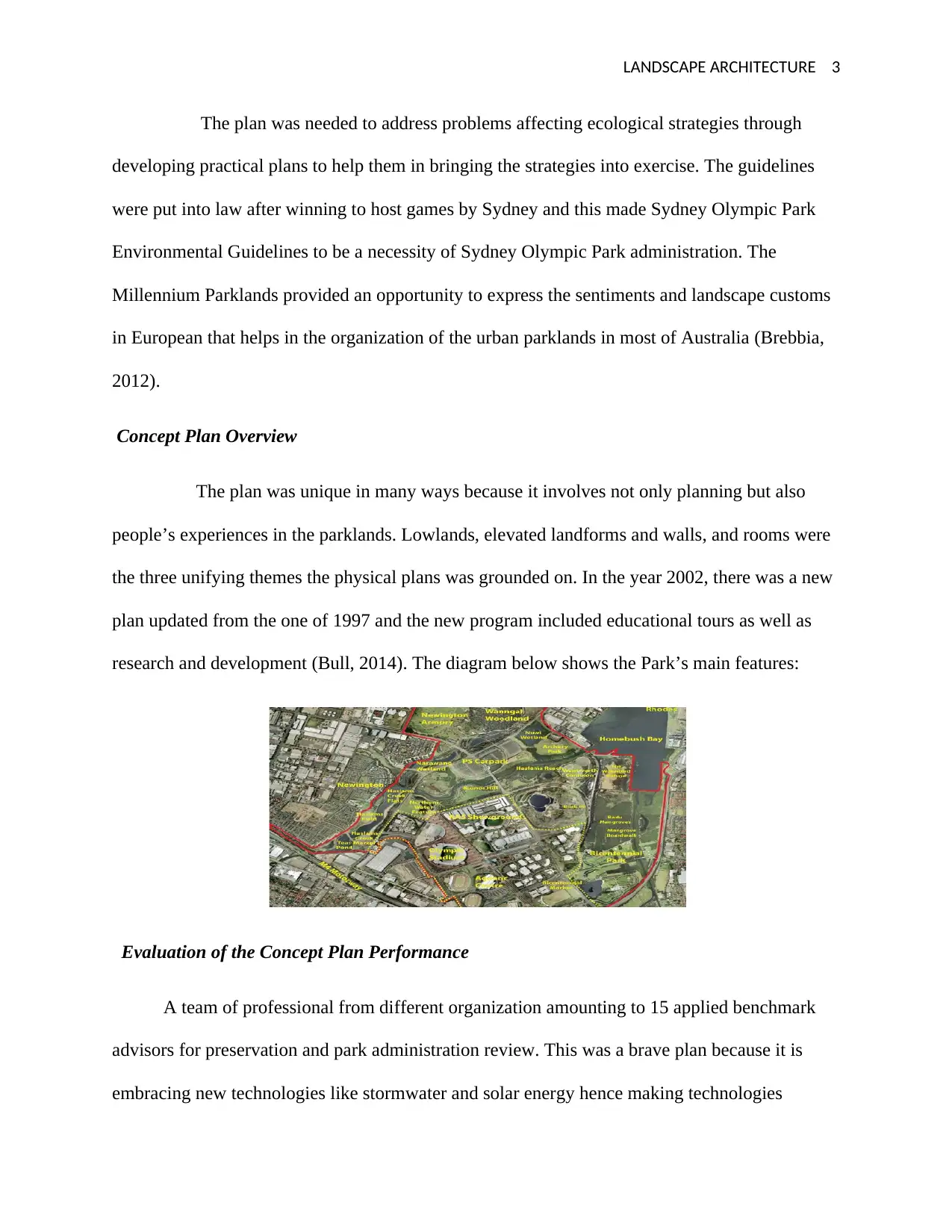
LANDSCAPE ARCHITECTURE 3
The plan was needed to address problems affecting ecological strategies through
developing practical plans to help them in bringing the strategies into exercise. The guidelines
were put into law after winning to host games by Sydney and this made Sydney Olympic Park
Environmental Guidelines to be a necessity of Sydney Olympic Park administration. The
Millennium Parklands provided an opportunity to express the sentiments and landscape customs
in European that helps in the organization of the urban parklands in most of Australia (Brebbia,
2012).
Concept Plan Overview
The plan was unique in many ways because it involves not only planning but also
people’s experiences in the parklands. Lowlands, elevated landforms and walls, and rooms were
the three unifying themes the physical plans was grounded on. In the year 2002, there was a new
plan updated from the one of 1997 and the new program included educational tours as well as
research and development (Bull, 2014). The diagram below shows the Park’s main features:
Evaluation of the Concept Plan Performance
A team of professional from different organization amounting to 15 applied benchmark
advisors for preservation and park administration review. This was a brave plan because it is
embracing new technologies like stormwater and solar energy hence making technologies
The plan was needed to address problems affecting ecological strategies through
developing practical plans to help them in bringing the strategies into exercise. The guidelines
were put into law after winning to host games by Sydney and this made Sydney Olympic Park
Environmental Guidelines to be a necessity of Sydney Olympic Park administration. The
Millennium Parklands provided an opportunity to express the sentiments and landscape customs
in European that helps in the organization of the urban parklands in most of Australia (Brebbia,
2012).
Concept Plan Overview
The plan was unique in many ways because it involves not only planning but also
people’s experiences in the parklands. Lowlands, elevated landforms and walls, and rooms were
the three unifying themes the physical plans was grounded on. In the year 2002, there was a new
plan updated from the one of 1997 and the new program included educational tours as well as
research and development (Bull, 2014). The diagram below shows the Park’s main features:
Evaluation of the Concept Plan Performance
A team of professional from different organization amounting to 15 applied benchmark
advisors for preservation and park administration review. This was a brave plan because it is
embracing new technologies like stormwater and solar energy hence making technologies
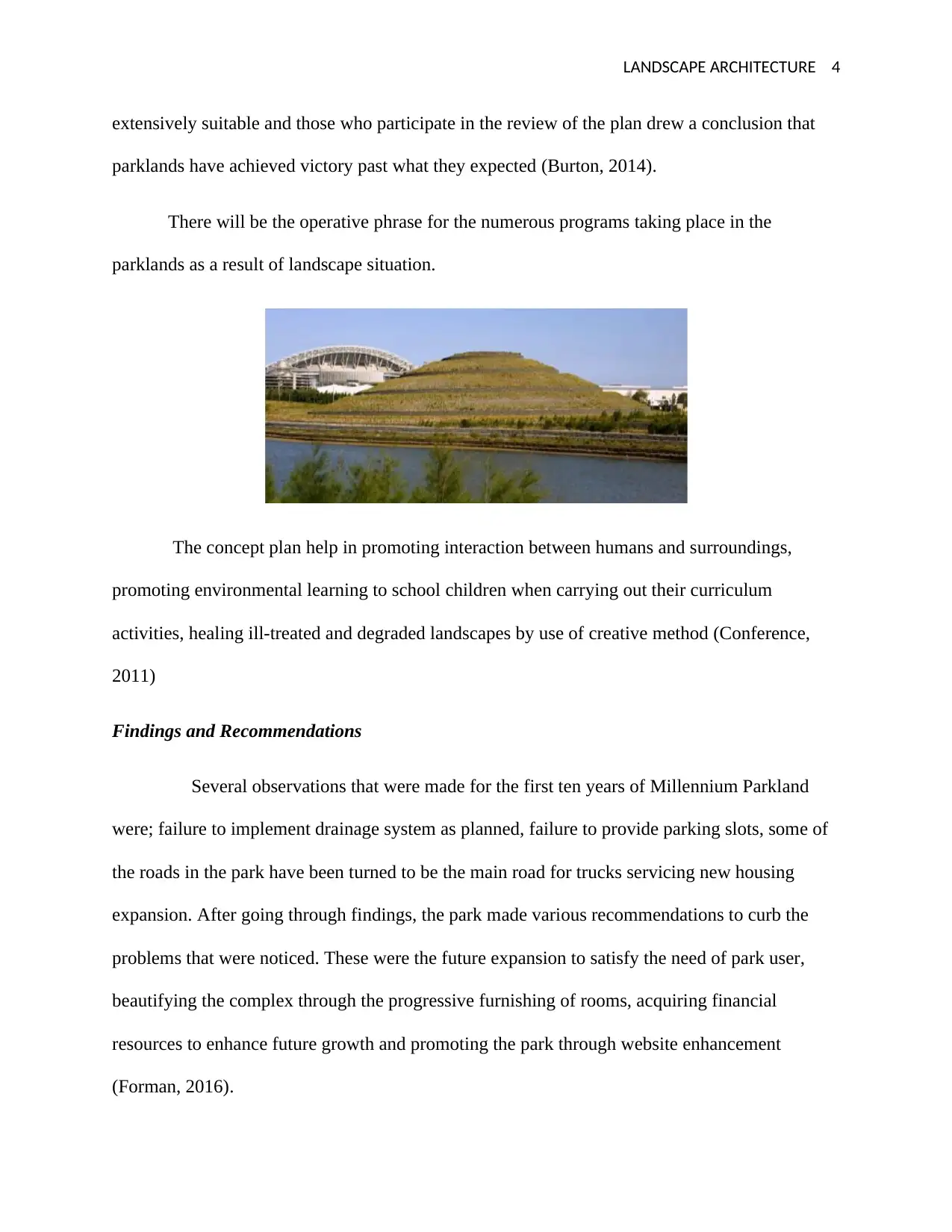
LANDSCAPE ARCHITECTURE 4
extensively suitable and those who participate in the review of the plan drew a conclusion that
parklands have achieved victory past what they expected (Burton, 2014).
There will be the operative phrase for the numerous programs taking place in the
parklands as a result of landscape situation.
The concept plan help in promoting interaction between humans and surroundings,
promoting environmental learning to school children when carrying out their curriculum
activities, healing ill-treated and degraded landscapes by use of creative method (Conference,
2011)
Findings and Recommendations
Several observations that were made for the first ten years of Millennium Parkland
were; failure to implement drainage system as planned, failure to provide parking slots, some of
the roads in the park have been turned to be the main road for trucks servicing new housing
expansion. After going through findings, the park made various recommendations to curb the
problems that were noticed. These were the future expansion to satisfy the need of park user,
beautifying the complex through the progressive furnishing of rooms, acquiring financial
resources to enhance future growth and promoting the park through website enhancement
(Forman, 2016).
extensively suitable and those who participate in the review of the plan drew a conclusion that
parklands have achieved victory past what they expected (Burton, 2014).
There will be the operative phrase for the numerous programs taking place in the
parklands as a result of landscape situation.
The concept plan help in promoting interaction between humans and surroundings,
promoting environmental learning to school children when carrying out their curriculum
activities, healing ill-treated and degraded landscapes by use of creative method (Conference,
2011)
Findings and Recommendations
Several observations that were made for the first ten years of Millennium Parkland
were; failure to implement drainage system as planned, failure to provide parking slots, some of
the roads in the park have been turned to be the main road for trucks servicing new housing
expansion. After going through findings, the park made various recommendations to curb the
problems that were noticed. These were the future expansion to satisfy the need of park user,
beautifying the complex through the progressive furnishing of rooms, acquiring financial
resources to enhance future growth and promoting the park through website enhancement
(Forman, 2016).
Secure Best Marks with AI Grader
Need help grading? Try our AI Grader for instant feedback on your assignments.
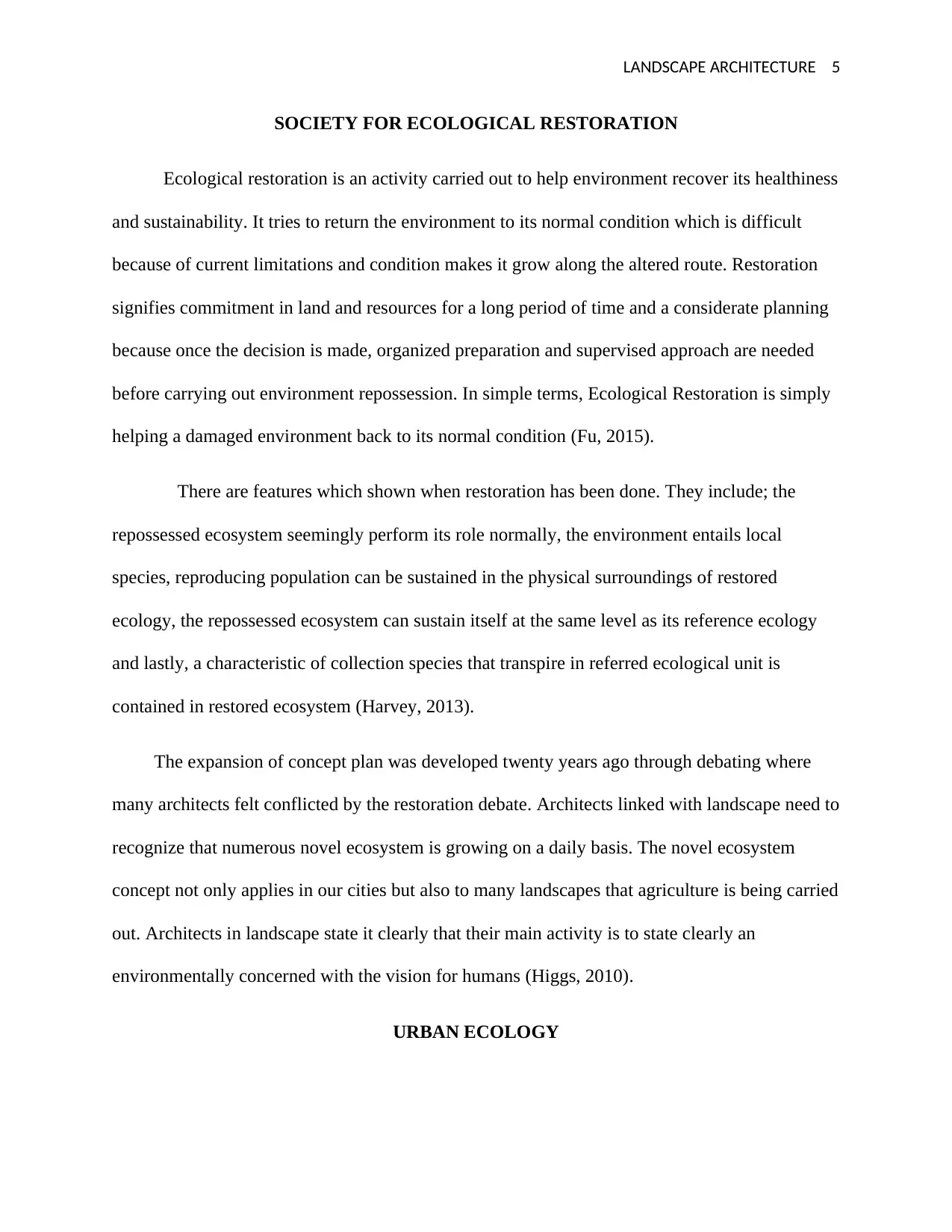
LANDSCAPE ARCHITECTURE 5
SOCIETY FOR ECOLOGICAL RESTORATION
Ecological restoration is an activity carried out to help environment recover its healthiness
and sustainability. It tries to return the environment to its normal condition which is difficult
because of current limitations and condition makes it grow along the altered route. Restoration
signifies commitment in land and resources for a long period of time and a considerate planning
because once the decision is made, organized preparation and supervised approach are needed
before carrying out environment repossession. In simple terms, Ecological Restoration is simply
helping a damaged environment back to its normal condition (Fu, 2015).
There are features which shown when restoration has been done. They include; the
repossessed ecosystem seemingly perform its role normally, the environment entails local
species, reproducing population can be sustained in the physical surroundings of restored
ecology, the repossessed ecosystem can sustain itself at the same level as its reference ecology
and lastly, a characteristic of collection species that transpire in referred ecological unit is
contained in restored ecosystem (Harvey, 2013).
The expansion of concept plan was developed twenty years ago through debating where
many architects felt conflicted by the restoration debate. Architects linked with landscape need to
recognize that numerous novel ecosystem is growing on a daily basis. The novel ecosystem
concept not only applies in our cities but also to many landscapes that agriculture is being carried
out. Architects in landscape state it clearly that their main activity is to state clearly an
environmentally concerned with the vision for humans (Higgs, 2010).
URBAN ECOLOGY
SOCIETY FOR ECOLOGICAL RESTORATION
Ecological restoration is an activity carried out to help environment recover its healthiness
and sustainability. It tries to return the environment to its normal condition which is difficult
because of current limitations and condition makes it grow along the altered route. Restoration
signifies commitment in land and resources for a long period of time and a considerate planning
because once the decision is made, organized preparation and supervised approach are needed
before carrying out environment repossession. In simple terms, Ecological Restoration is simply
helping a damaged environment back to its normal condition (Fu, 2015).
There are features which shown when restoration has been done. They include; the
repossessed ecosystem seemingly perform its role normally, the environment entails local
species, reproducing population can be sustained in the physical surroundings of restored
ecology, the repossessed ecosystem can sustain itself at the same level as its reference ecology
and lastly, a characteristic of collection species that transpire in referred ecological unit is
contained in restored ecosystem (Harvey, 2013).
The expansion of concept plan was developed twenty years ago through debating where
many architects felt conflicted by the restoration debate. Architects linked with landscape need to
recognize that numerous novel ecosystem is growing on a daily basis. The novel ecosystem
concept not only applies in our cities but also to many landscapes that agriculture is being carried
out. Architects in landscape state it clearly that their main activity is to state clearly an
environmentally concerned with the vision for humans (Higgs, 2010).
URBAN ECOLOGY
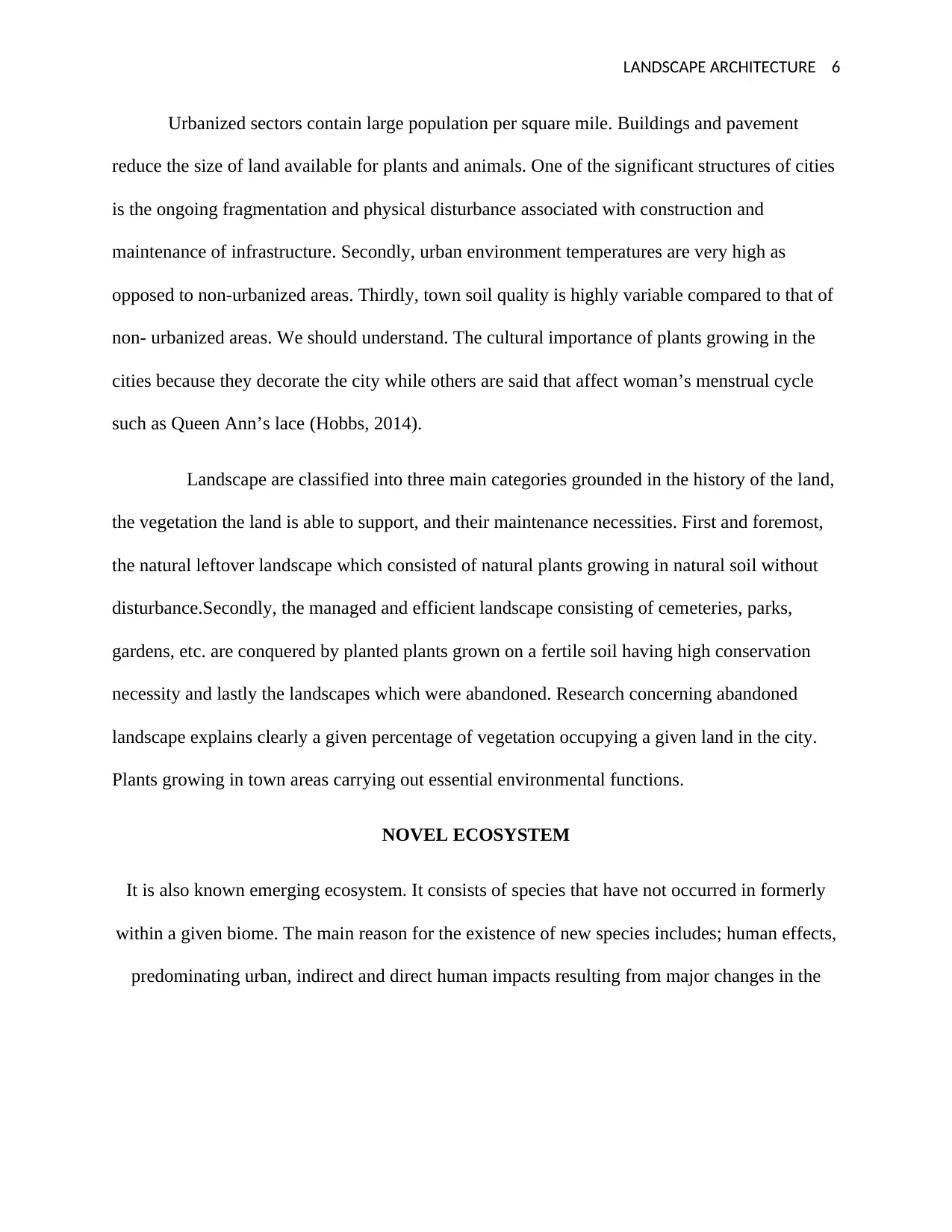
LANDSCAPE ARCHITECTURE 6
Urbanized sectors contain large population per square mile. Buildings and pavement
reduce the size of land available for plants and animals. One of the significant structures of cities
is the ongoing fragmentation and physical disturbance associated with construction and
maintenance of infrastructure. Secondly, urban environment temperatures are very high as
opposed to non-urbanized areas. Thirdly, town soil quality is highly variable compared to that of
non- urbanized areas. We should understand. The cultural importance of plants growing in the
cities because they decorate the city while others are said that affect woman’s menstrual cycle
such as Queen Ann’s lace (Hobbs, 2014).
Landscape are classified into three main categories grounded in the history of the land,
the vegetation the land is able to support, and their maintenance necessities. First and foremost,
the natural leftover landscape which consisted of natural plants growing in natural soil without
disturbance.Secondly, the managed and efficient landscape consisting of cemeteries, parks,
gardens, etc. are conquered by planted plants grown on a fertile soil having high conservation
necessity and lastly the landscapes which were abandoned. Research concerning abandoned
landscape explains clearly a given percentage of vegetation occupying a given land in the city.
Plants growing in town areas carrying out essential environmental functions.
NOVEL ECOSYSTEM
It is also known emerging ecosystem. It consists of species that have not occurred in formerly
within a given biome. The main reason for the existence of new species includes; human effects,
predominating urban, indirect and direct human impacts resulting from major changes in the
Urbanized sectors contain large population per square mile. Buildings and pavement
reduce the size of land available for plants and animals. One of the significant structures of cities
is the ongoing fragmentation and physical disturbance associated with construction and
maintenance of infrastructure. Secondly, urban environment temperatures are very high as
opposed to non-urbanized areas. Thirdly, town soil quality is highly variable compared to that of
non- urbanized areas. We should understand. The cultural importance of plants growing in the
cities because they decorate the city while others are said that affect woman’s menstrual cycle
such as Queen Ann’s lace (Hobbs, 2014).
Landscape are classified into three main categories grounded in the history of the land,
the vegetation the land is able to support, and their maintenance necessities. First and foremost,
the natural leftover landscape which consisted of natural plants growing in natural soil without
disturbance.Secondly, the managed and efficient landscape consisting of cemeteries, parks,
gardens, etc. are conquered by planted plants grown on a fertile soil having high conservation
necessity and lastly the landscapes which were abandoned. Research concerning abandoned
landscape explains clearly a given percentage of vegetation occupying a given land in the city.
Plants growing in town areas carrying out essential environmental functions.
NOVEL ECOSYSTEM
It is also known emerging ecosystem. It consists of species that have not occurred in formerly
within a given biome. The main reason for the existence of new species includes; human effects,
predominating urban, indirect and direct human impacts resulting from major changes in the
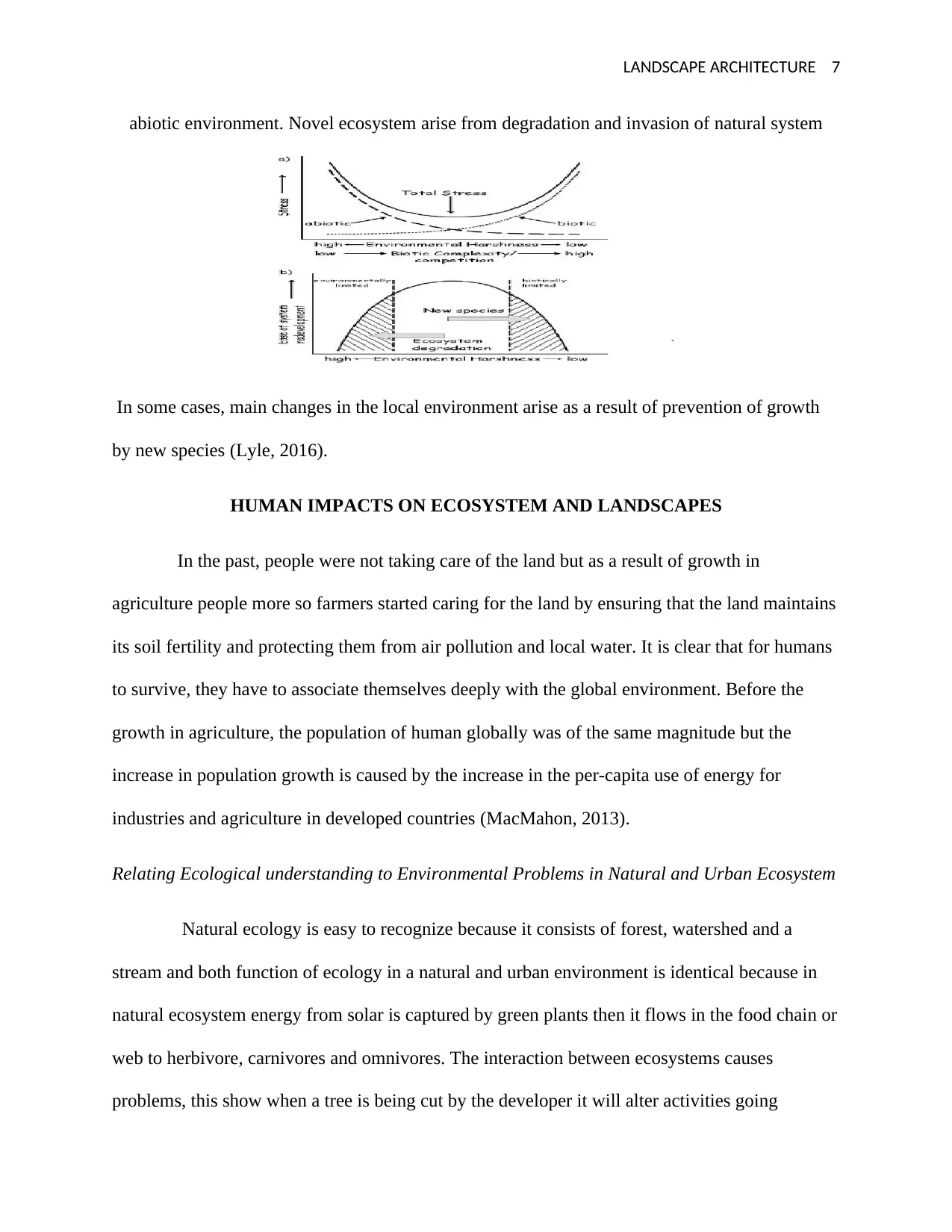
LANDSCAPE ARCHITECTURE 7
abiotic environment. Novel ecosystem arise from degradation and invasion of natural system
In some cases, main changes in the local environment arise as a result of prevention of growth
by new species (Lyle, 2016).
HUMAN IMPACTS ON ECOSYSTEM AND LANDSCAPES
In the past, people were not taking care of the land but as a result of growth in
agriculture people more so farmers started caring for the land by ensuring that the land maintains
its soil fertility and protecting them from air pollution and local water. It is clear that for humans
to survive, they have to associate themselves deeply with the global environment. Before the
growth in agriculture, the population of human globally was of the same magnitude but the
increase in population growth is caused by the increase in the per-capita use of energy for
industries and agriculture in developed countries (MacMahon, 2013).
Relating Ecological understanding to Environmental Problems in Natural and Urban Ecosystem
Natural ecology is easy to recognize because it consists of forest, watershed and a
stream and both function of ecology in a natural and urban environment is identical because in
natural ecosystem energy from solar is captured by green plants then it flows in the food chain or
web to herbivore, carnivores and omnivores. The interaction between ecosystems causes
problems, this show when a tree is being cut by the developer it will alter activities going
abiotic environment. Novel ecosystem arise from degradation and invasion of natural system
In some cases, main changes in the local environment arise as a result of prevention of growth
by new species (Lyle, 2016).
HUMAN IMPACTS ON ECOSYSTEM AND LANDSCAPES
In the past, people were not taking care of the land but as a result of growth in
agriculture people more so farmers started caring for the land by ensuring that the land maintains
its soil fertility and protecting them from air pollution and local water. It is clear that for humans
to survive, they have to associate themselves deeply with the global environment. Before the
growth in agriculture, the population of human globally was of the same magnitude but the
increase in population growth is caused by the increase in the per-capita use of energy for
industries and agriculture in developed countries (MacMahon, 2013).
Relating Ecological understanding to Environmental Problems in Natural and Urban Ecosystem
Natural ecology is easy to recognize because it consists of forest, watershed and a
stream and both function of ecology in a natural and urban environment is identical because in
natural ecosystem energy from solar is captured by green plants then it flows in the food chain or
web to herbivore, carnivores and omnivores. The interaction between ecosystems causes
problems, this show when a tree is being cut by the developer it will alter activities going
Paraphrase This Document
Need a fresh take? Get an instant paraphrase of this document with our AI Paraphraser
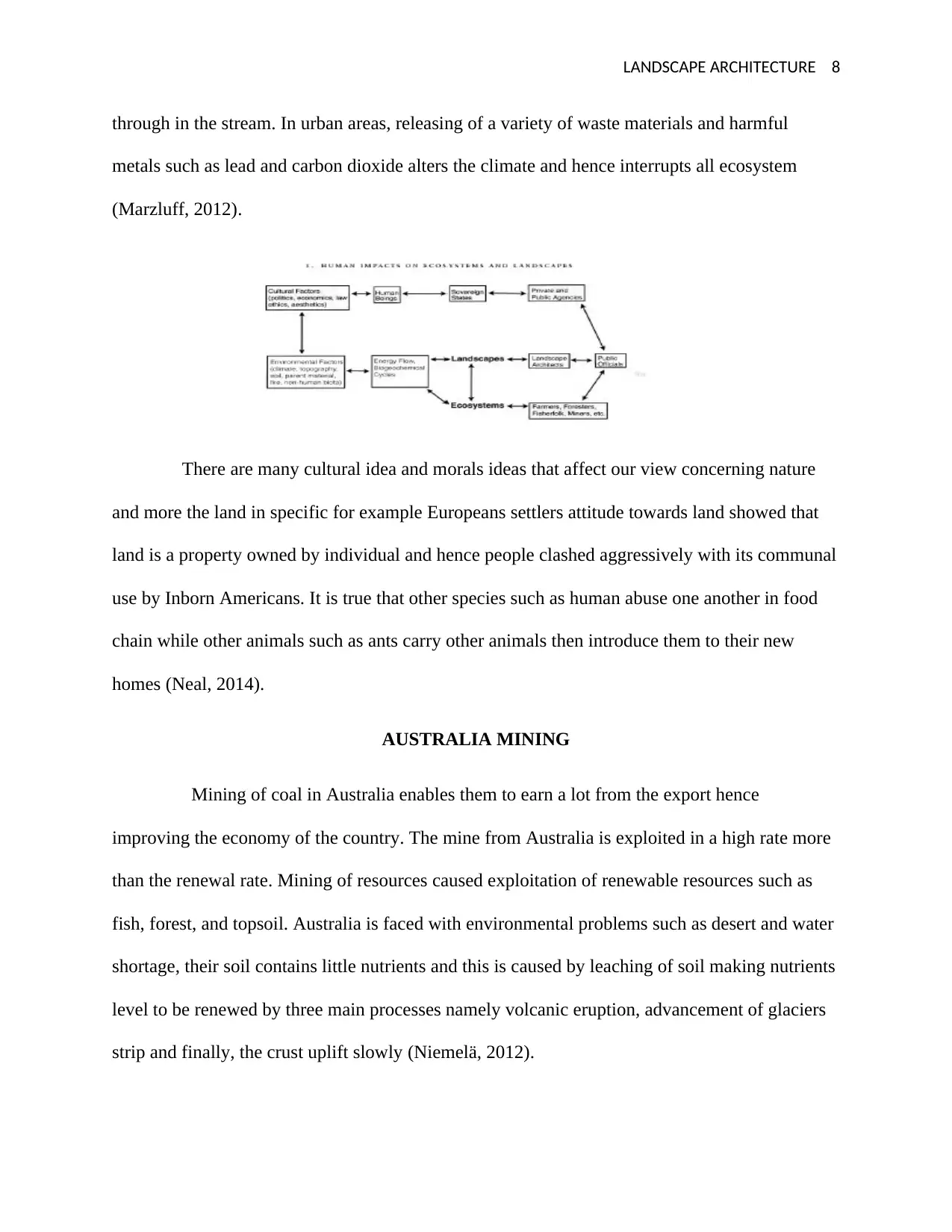
LANDSCAPE ARCHITECTURE 8
through in the stream. In urban areas, releasing of a variety of waste materials and harmful
metals such as lead and carbon dioxide alters the climate and hence interrupts all ecosystem
(Marzluff, 2012).
There are many cultural idea and morals ideas that affect our view concerning nature
and more the land in specific for example Europeans settlers attitude towards land showed that
land is a property owned by individual and hence people clashed aggressively with its communal
use by Inborn Americans. It is true that other species such as human abuse one another in food
chain while other animals such as ants carry other animals then introduce them to their new
homes (Neal, 2014).
AUSTRALIA MINING
Mining of coal in Australia enables them to earn a lot from the export hence
improving the economy of the country. The mine from Australia is exploited in a high rate more
than the renewal rate. Mining of resources caused exploitation of renewable resources such as
fish, forest, and topsoil. Australia is faced with environmental problems such as desert and water
shortage, their soil contains little nutrients and this is caused by leaching of soil making nutrients
level to be renewed by three main processes namely volcanic eruption, advancement of glaciers
strip and finally, the crust uplift slowly (Niemelä, 2012).
through in the stream. In urban areas, releasing of a variety of waste materials and harmful
metals such as lead and carbon dioxide alters the climate and hence interrupts all ecosystem
(Marzluff, 2012).
There are many cultural idea and morals ideas that affect our view concerning nature
and more the land in specific for example Europeans settlers attitude towards land showed that
land is a property owned by individual and hence people clashed aggressively with its communal
use by Inborn Americans. It is true that other species such as human abuse one another in food
chain while other animals such as ants carry other animals then introduce them to their new
homes (Neal, 2014).
AUSTRALIA MINING
Mining of coal in Australia enables them to earn a lot from the export hence
improving the economy of the country. The mine from Australia is exploited in a high rate more
than the renewal rate. Mining of resources caused exploitation of renewable resources such as
fish, forest, and topsoil. Australia is faced with environmental problems such as desert and water
shortage, their soil contains little nutrients and this is caused by leaching of soil making nutrients
level to be renewed by three main processes namely volcanic eruption, advancement of glaciers
strip and finally, the crust uplift slowly (Niemelä, 2012).
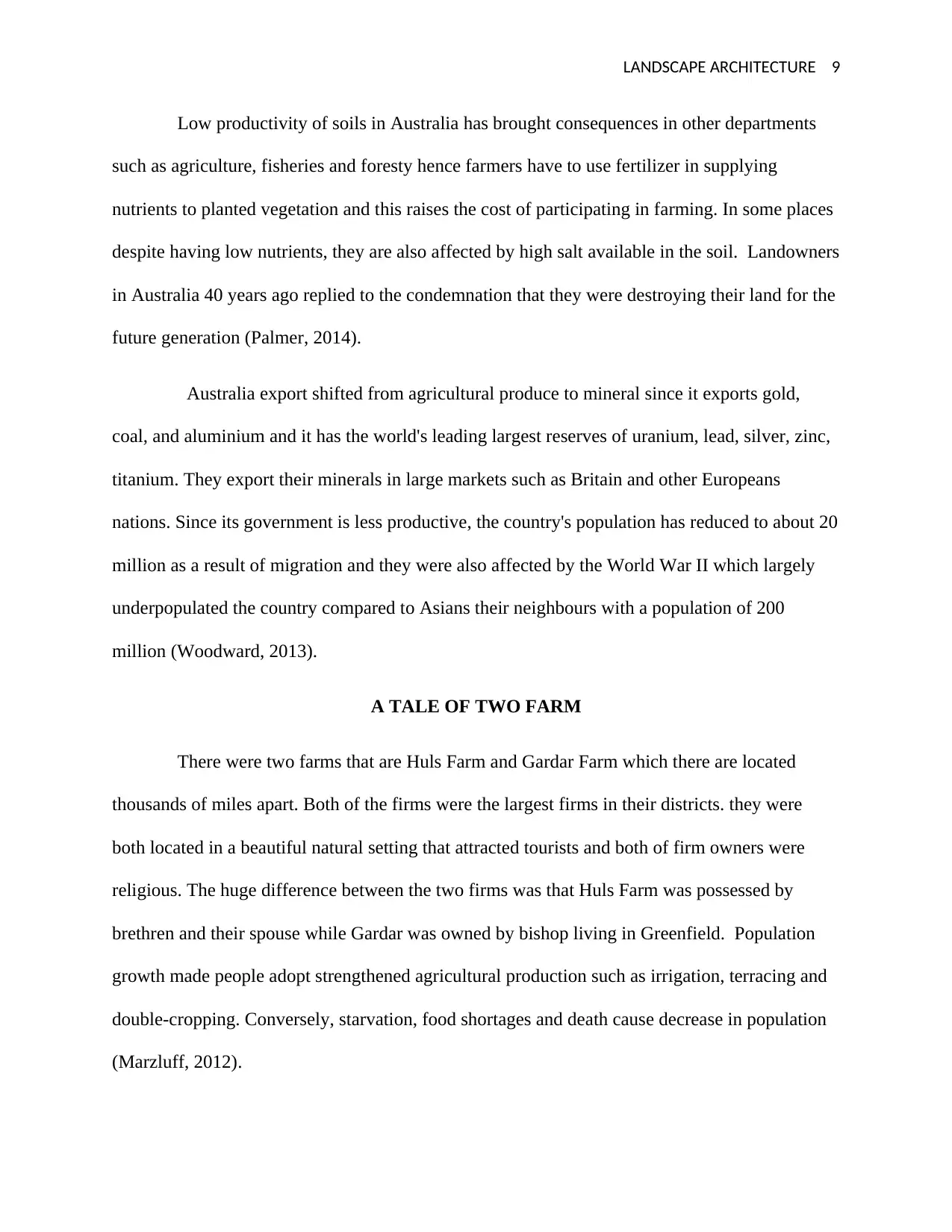
LANDSCAPE ARCHITECTURE 9
Low productivity of soils in Australia has brought consequences in other departments
such as agriculture, fisheries and foresty hence farmers have to use fertilizer in supplying
nutrients to planted vegetation and this raises the cost of participating in farming. In some places
despite having low nutrients, they are also affected by high salt available in the soil. Landowners
in Australia 40 years ago replied to the condemnation that they were destroying their land for the
future generation (Palmer, 2014).
Australia export shifted from agricultural produce to mineral since it exports gold,
coal, and aluminium and it has the world's leading largest reserves of uranium, lead, silver, zinc,
titanium. They export their minerals in large markets such as Britain and other Europeans
nations. Since its government is less productive, the country's population has reduced to about 20
million as a result of migration and they were also affected by the World War II which largely
underpopulated the country compared to Asians their neighbours with a population of 200
million (Woodward, 2013).
A TALE OF TWO FARM
There were two farms that are Huls Farm and Gardar Farm which there are located
thousands of miles apart. Both of the firms were the largest firms in their districts. they were
both located in a beautiful natural setting that attracted tourists and both of firm owners were
religious. The huge difference between the two firms was that Huls Farm was possessed by
brethren and their spouse while Gardar was owned by bishop living in Greenfield. Population
growth made people adopt strengthened agricultural production such as irrigation, terracing and
double-cropping. Conversely, starvation, food shortages and death cause decrease in population
(Marzluff, 2012).
Low productivity of soils in Australia has brought consequences in other departments
such as agriculture, fisheries and foresty hence farmers have to use fertilizer in supplying
nutrients to planted vegetation and this raises the cost of participating in farming. In some places
despite having low nutrients, they are also affected by high salt available in the soil. Landowners
in Australia 40 years ago replied to the condemnation that they were destroying their land for the
future generation (Palmer, 2014).
Australia export shifted from agricultural produce to mineral since it exports gold,
coal, and aluminium and it has the world's leading largest reserves of uranium, lead, silver, zinc,
titanium. They export their minerals in large markets such as Britain and other Europeans
nations. Since its government is less productive, the country's population has reduced to about 20
million as a result of migration and they were also affected by the World War II which largely
underpopulated the country compared to Asians their neighbours with a population of 200
million (Woodward, 2013).
A TALE OF TWO FARM
There were two farms that are Huls Farm and Gardar Farm which there are located
thousands of miles apart. Both of the firms were the largest firms in their districts. they were
both located in a beautiful natural setting that attracted tourists and both of firm owners were
religious. The huge difference between the two firms was that Huls Farm was possessed by
brethren and their spouse while Gardar was owned by bishop living in Greenfield. Population
growth made people adopt strengthened agricultural production such as irrigation, terracing and
double-cropping. Conversely, starvation, food shortages and death cause decrease in population
(Marzluff, 2012).
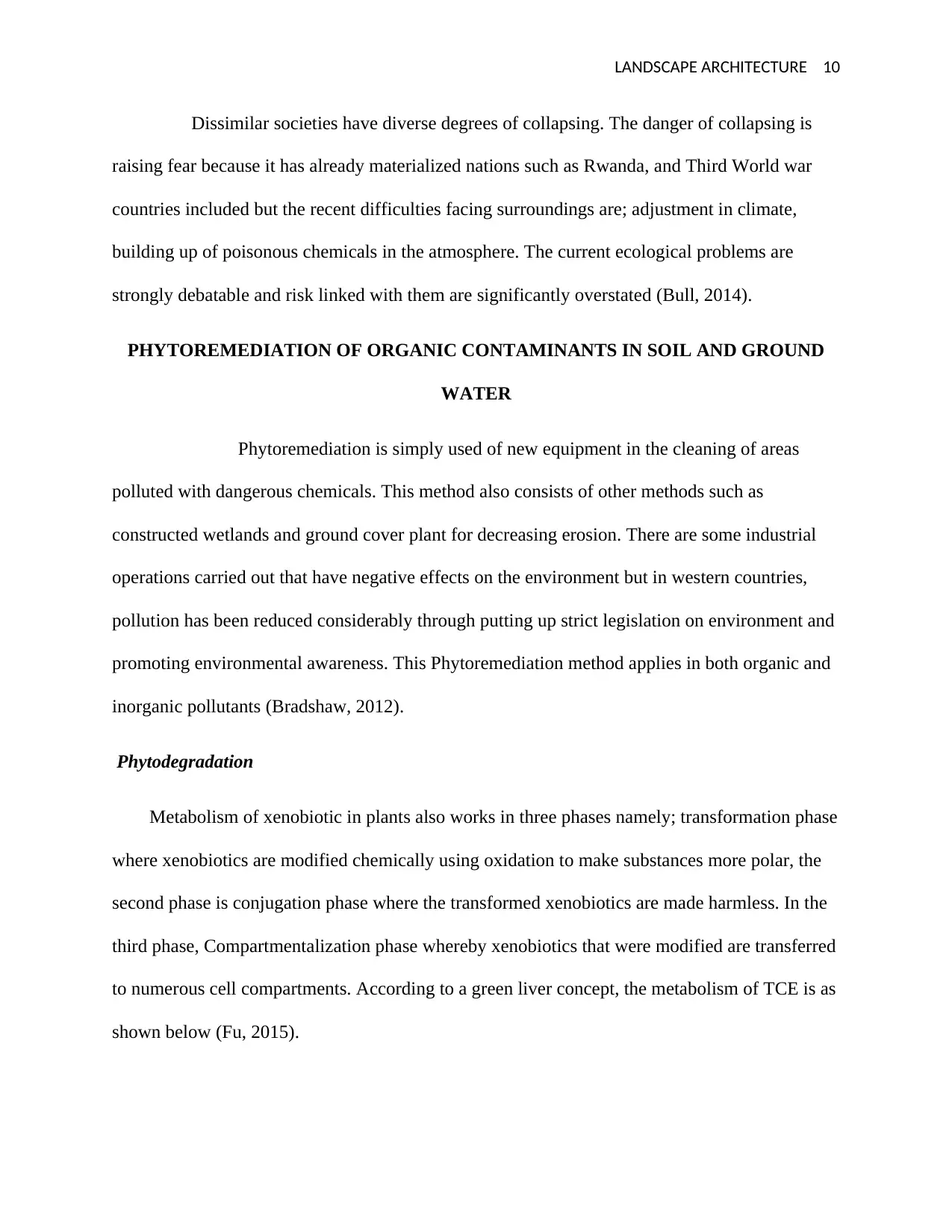
LANDSCAPE ARCHITECTURE 10
Dissimilar societies have diverse degrees of collapsing. The danger of collapsing is
raising fear because it has already materialized nations such as Rwanda, and Third World war
countries included but the recent difficulties facing surroundings are; adjustment in climate,
building up of poisonous chemicals in the atmosphere. The current ecological problems are
strongly debatable and risk linked with them are significantly overstated (Bull, 2014).
PHYTOREMEDIATION OF ORGANIC CONTAMINANTS IN SOIL AND GROUND
WATER
Phytoremediation is simply used of new equipment in the cleaning of areas
polluted with dangerous chemicals. This method also consists of other methods such as
constructed wetlands and ground cover plant for decreasing erosion. There are some industrial
operations carried out that have negative effects on the environment but in western countries,
pollution has been reduced considerably through putting up strict legislation on environment and
promoting environmental awareness. This Phytoremediation method applies in both organic and
inorganic pollutants (Bradshaw, 2012).
Phytodegradation
Metabolism of xenobiotic in plants also works in three phases namely; transformation phase
where xenobiotics are modified chemically using oxidation to make substances more polar, the
second phase is conjugation phase where the transformed xenobiotics are made harmless. In the
third phase, Compartmentalization phase whereby xenobiotics that were modified are transferred
to numerous cell compartments. According to a green liver concept, the metabolism of TCE is as
shown below (Fu, 2015).
Dissimilar societies have diverse degrees of collapsing. The danger of collapsing is
raising fear because it has already materialized nations such as Rwanda, and Third World war
countries included but the recent difficulties facing surroundings are; adjustment in climate,
building up of poisonous chemicals in the atmosphere. The current ecological problems are
strongly debatable and risk linked with them are significantly overstated (Bull, 2014).
PHYTOREMEDIATION OF ORGANIC CONTAMINANTS IN SOIL AND GROUND
WATER
Phytoremediation is simply used of new equipment in the cleaning of areas
polluted with dangerous chemicals. This method also consists of other methods such as
constructed wetlands and ground cover plant for decreasing erosion. There are some industrial
operations carried out that have negative effects on the environment but in western countries,
pollution has been reduced considerably through putting up strict legislation on environment and
promoting environmental awareness. This Phytoremediation method applies in both organic and
inorganic pollutants (Bradshaw, 2012).
Phytodegradation
Metabolism of xenobiotic in plants also works in three phases namely; transformation phase
where xenobiotics are modified chemically using oxidation to make substances more polar, the
second phase is conjugation phase where the transformed xenobiotics are made harmless. In the
third phase, Compartmentalization phase whereby xenobiotics that were modified are transferred
to numerous cell compartments. According to a green liver concept, the metabolism of TCE is as
shown below (Fu, 2015).
Secure Best Marks with AI Grader
Need help grading? Try our AI Grader for instant feedback on your assignments.
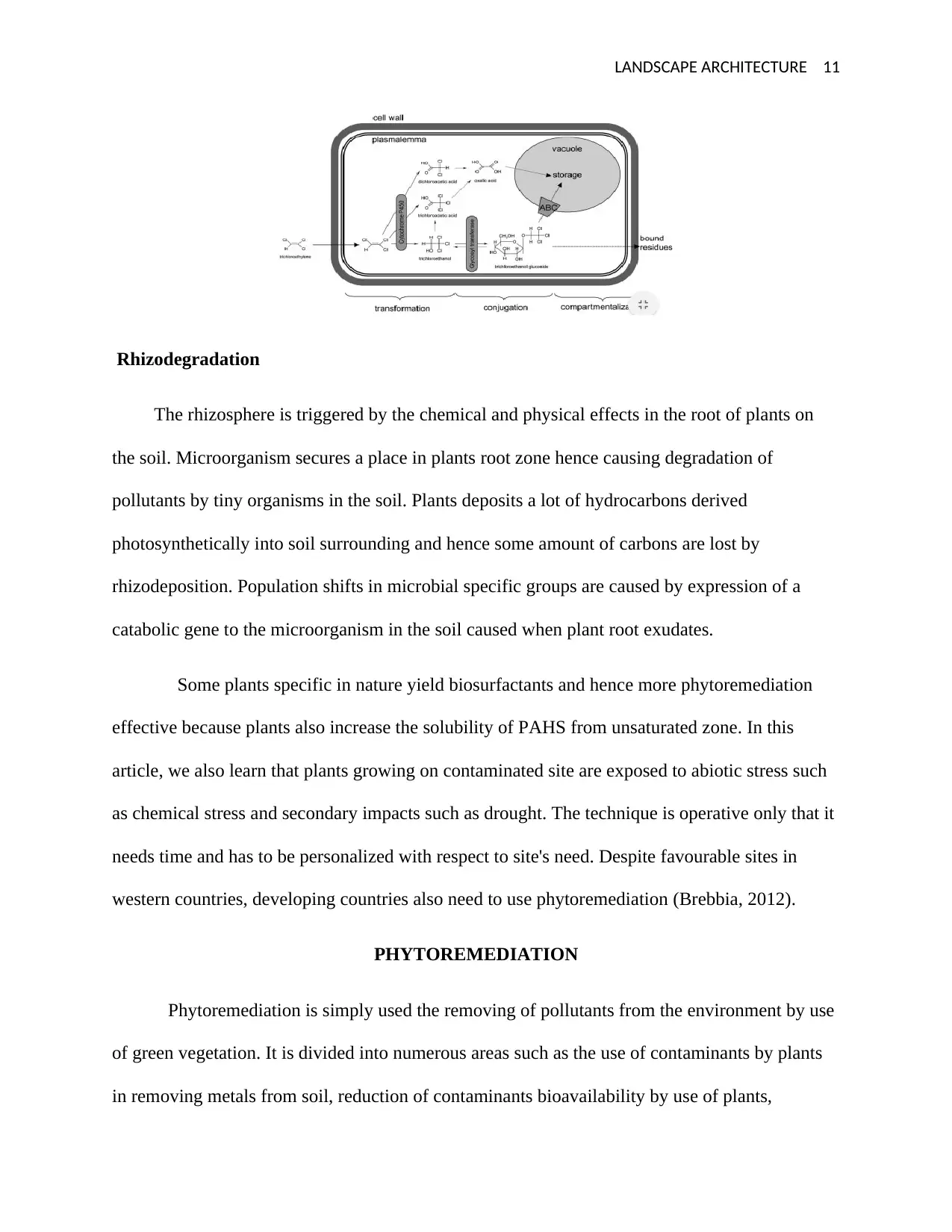
LANDSCAPE ARCHITECTURE 11
Rhizodegradation
The rhizosphere is triggered by the chemical and physical effects in the root of plants on
the soil. Microorganism secures a place in plants root zone hence causing degradation of
pollutants by tiny organisms in the soil. Plants deposits a lot of hydrocarbons derived
photosynthetically into soil surrounding and hence some amount of carbons are lost by
rhizodeposition. Population shifts in microbial specific groups are caused by expression of a
catabolic gene to the microorganism in the soil caused when plant root exudates.
Some plants specific in nature yield biosurfactants and hence more phytoremediation
effective because plants also increase the solubility of PAHS from unsaturated zone. In this
article, we also learn that plants growing on contaminated site are exposed to abiotic stress such
as chemical stress and secondary impacts such as drought. The technique is operative only that it
needs time and has to be personalized with respect to site's need. Despite favourable sites in
western countries, developing countries also need to use phytoremediation (Brebbia, 2012).
PHYTOREMEDIATION
Phytoremediation is simply used the removing of pollutants from the environment by use
of green vegetation. It is divided into numerous areas such as the use of contaminants by plants
in removing metals from soil, reduction of contaminants bioavailability by use of plants,
Rhizodegradation
The rhizosphere is triggered by the chemical and physical effects in the root of plants on
the soil. Microorganism secures a place in plants root zone hence causing degradation of
pollutants by tiny organisms in the soil. Plants deposits a lot of hydrocarbons derived
photosynthetically into soil surrounding and hence some amount of carbons are lost by
rhizodeposition. Population shifts in microbial specific groups are caused by expression of a
catabolic gene to the microorganism in the soil caused when plant root exudates.
Some plants specific in nature yield biosurfactants and hence more phytoremediation
effective because plants also increase the solubility of PAHS from unsaturated zone. In this
article, we also learn that plants growing on contaminated site are exposed to abiotic stress such
as chemical stress and secondary impacts such as drought. The technique is operative only that it
needs time and has to be personalized with respect to site's need. Despite favourable sites in
western countries, developing countries also need to use phytoremediation (Brebbia, 2012).
PHYTOREMEDIATION
Phytoremediation is simply used the removing of pollutants from the environment by use
of green vegetation. It is divided into numerous areas such as the use of contaminants by plants
in removing metals from soil, reduction of contaminants bioavailability by use of plants,
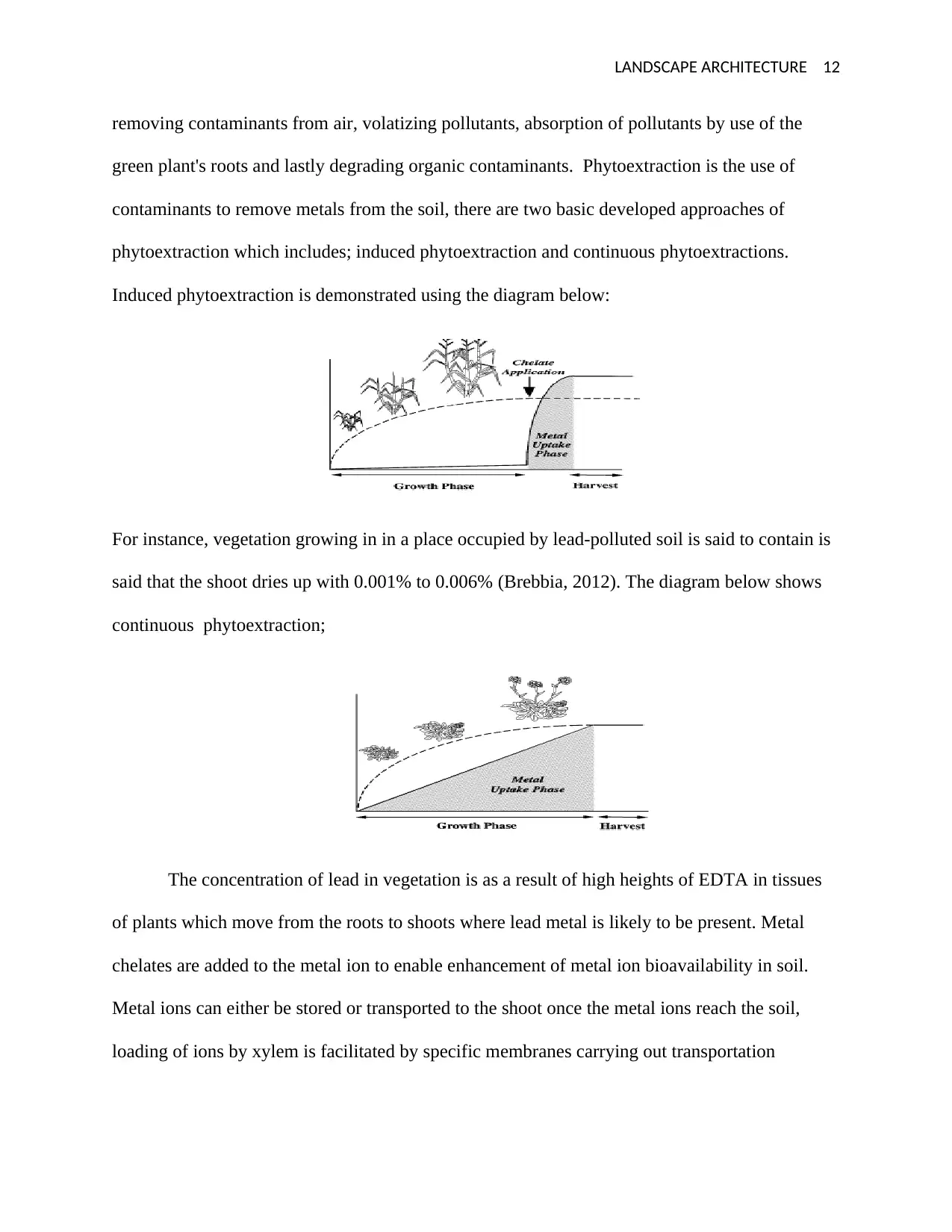
LANDSCAPE ARCHITECTURE 12
removing contaminants from air, volatizing pollutants, absorption of pollutants by use of the
green plant's roots and lastly degrading organic contaminants. Phytoextraction is the use of
contaminants to remove metals from the soil, there are two basic developed approaches of
phytoextraction which includes; induced phytoextraction and continuous phytoextractions.
Induced phytoextraction is demonstrated using the diagram below:
For instance, vegetation growing in in a place occupied by lead-polluted soil is said to contain is
said that the shoot dries up with 0.001% to 0.006% (Brebbia, 2012). The diagram below shows
continuous phytoextraction;
The concentration of lead in vegetation is as a result of high heights of EDTA in tissues
of plants which move from the roots to shoots where lead metal is likely to be present. Metal
chelates are added to the metal ion to enable enhancement of metal ion bioavailability in soil.
Metal ions can either be stored or transported to the shoot once the metal ions reach the soil,
loading of ions by xylem is facilitated by specific membranes carrying out transportation
removing contaminants from air, volatizing pollutants, absorption of pollutants by use of the
green plant's roots and lastly degrading organic contaminants. Phytoextraction is the use of
contaminants to remove metals from the soil, there are two basic developed approaches of
phytoextraction which includes; induced phytoextraction and continuous phytoextractions.
Induced phytoextraction is demonstrated using the diagram below:
For instance, vegetation growing in in a place occupied by lead-polluted soil is said to contain is
said that the shoot dries up with 0.001% to 0.006% (Brebbia, 2012). The diagram below shows
continuous phytoextraction;
The concentration of lead in vegetation is as a result of high heights of EDTA in tissues
of plants which move from the roots to shoots where lead metal is likely to be present. Metal
chelates are added to the metal ion to enable enhancement of metal ion bioavailability in soil.
Metal ions can either be stored or transported to the shoot once the metal ions reach the soil,
loading of ions by xylem is facilitated by specific membranes carrying out transportation
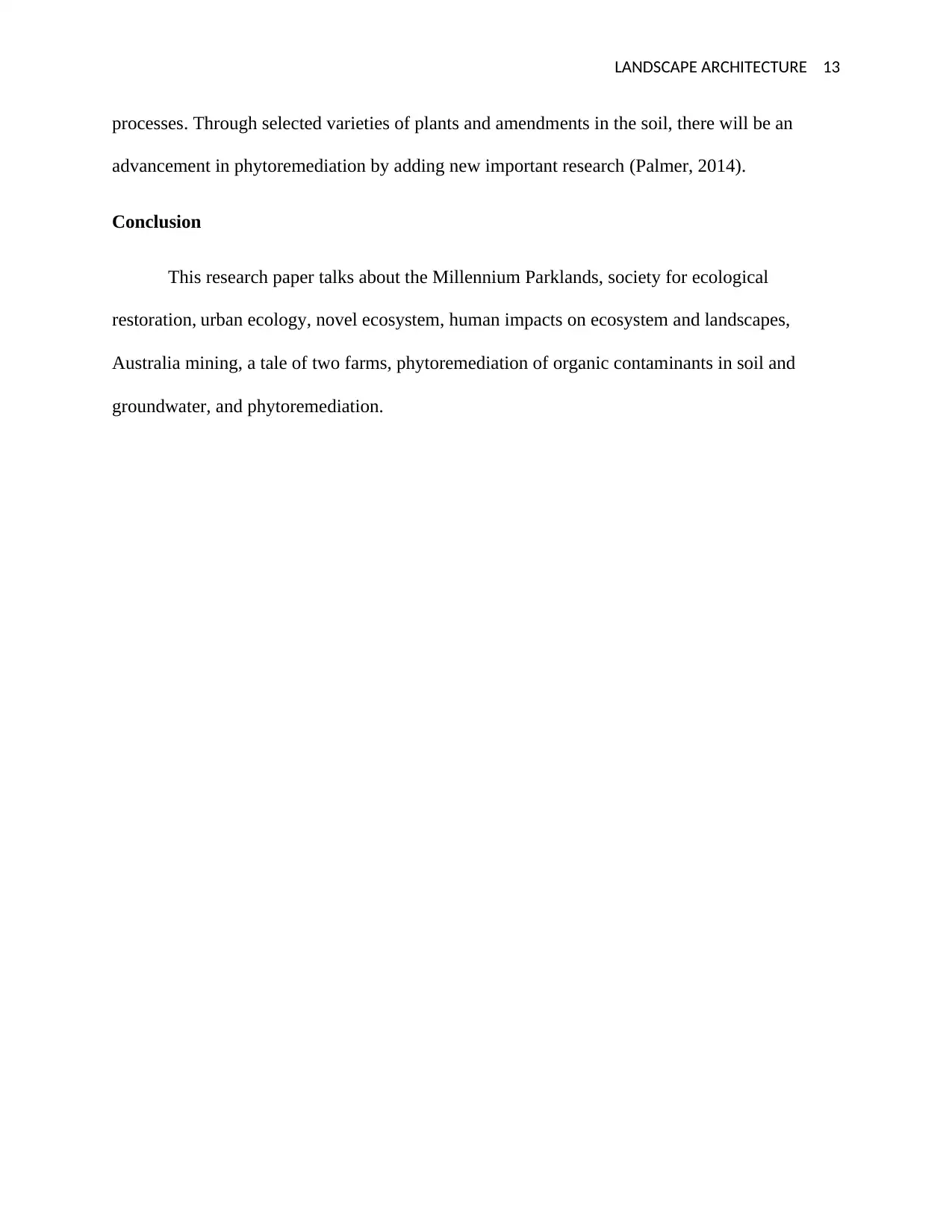
LANDSCAPE ARCHITECTURE 13
processes. Through selected varieties of plants and amendments in the soil, there will be an
advancement in phytoremediation by adding new important research (Palmer, 2014).
Conclusion
This research paper talks about the Millennium Parklands, society for ecological
restoration, urban ecology, novel ecosystem, human impacts on ecosystem and landscapes,
Australia mining, a tale of two farms, phytoremediation of organic contaminants in soil and
groundwater, and phytoremediation.
processes. Through selected varieties of plants and amendments in the soil, there will be an
advancement in phytoremediation by adding new important research (Palmer, 2014).
Conclusion
This research paper talks about the Millennium Parklands, society for ecological
restoration, urban ecology, novel ecosystem, human impacts on ecosystem and landscapes,
Australia mining, a tale of two farms, phytoremediation of organic contaminants in soil and
groundwater, and phytoremediation.
Paraphrase This Document
Need a fresh take? Get an instant paraphrase of this document with our AI Paraphraser
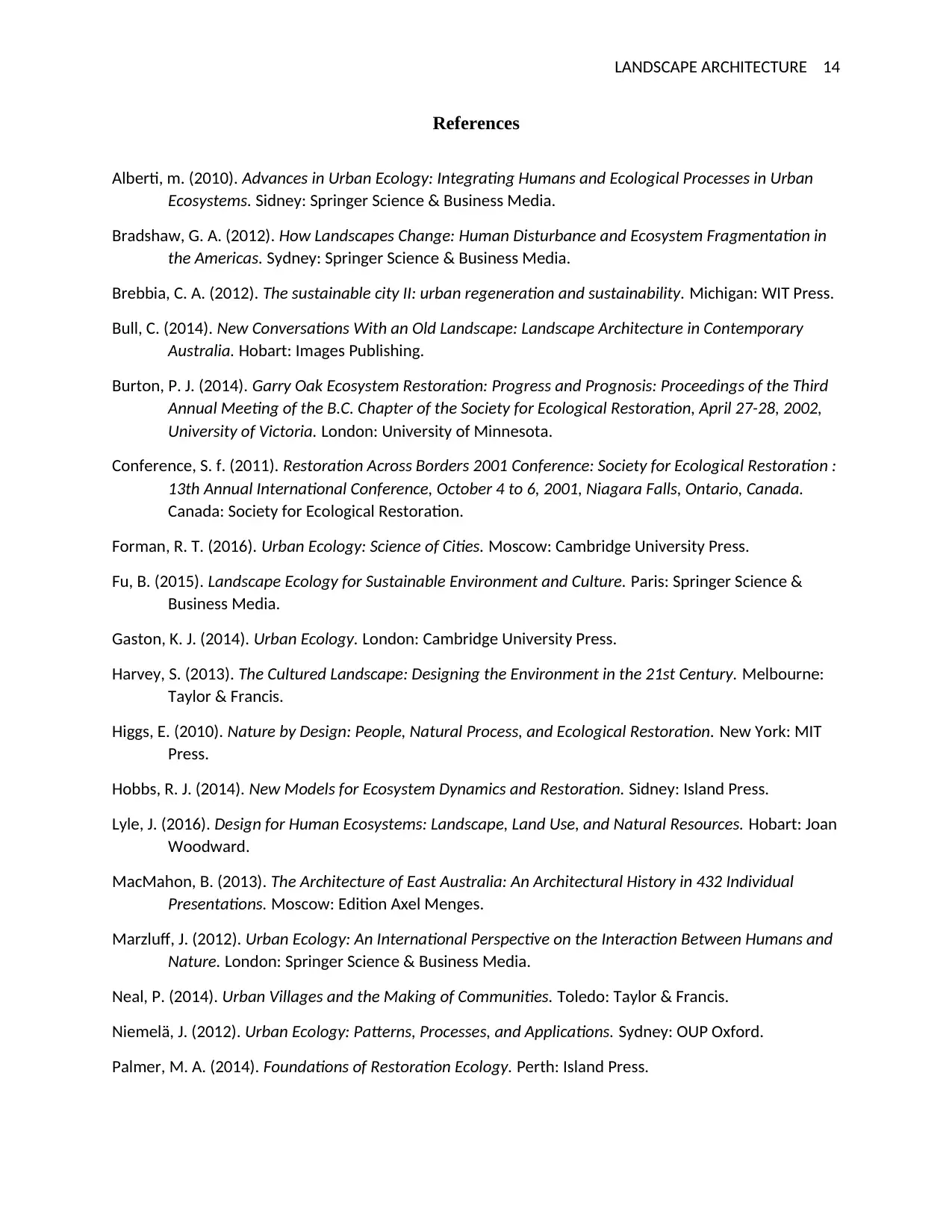
LANDSCAPE ARCHITECTURE 14
References
Alberti, m. (2010). Advances in Urban Ecology: Integrating Humans and Ecological Processes in Urban
Ecosystems. Sidney: Springer Science & Business Media.
Bradshaw, G. A. (2012). How Landscapes Change: Human Disturbance and Ecosystem Fragmentation in
the Americas. Sydney: Springer Science & Business Media.
Brebbia, C. A. (2012). The sustainable city II: urban regeneration and sustainability. Michigan: WIT Press.
Bull, C. (2014). New Conversations With an Old Landscape: Landscape Architecture in Contemporary
Australia. Hobart: Images Publishing.
Burton, P. J. (2014). Garry Oak Ecosystem Restoration: Progress and Prognosis: Proceedings of the Third
Annual Meeting of the B.C. Chapter of the Society for Ecological Restoration, April 27-28, 2002,
University of Victoria. London: University of Minnesota.
Conference, S. f. (2011). Restoration Across Borders 2001 Conference: Society for Ecological Restoration :
13th Annual International Conference, October 4 to 6, 2001, Niagara Falls, Ontario, Canada.
Canada: Society for Ecological Restoration.
Forman, R. T. (2016). Urban Ecology: Science of Cities. Moscow: Cambridge University Press.
Fu, B. (2015). Landscape Ecology for Sustainable Environment and Culture. Paris: Springer Science &
Business Media.
Gaston, K. J. (2014). Urban Ecology. London: Cambridge University Press.
Harvey, S. (2013). The Cultured Landscape: Designing the Environment in the 21st Century. Melbourne:
Taylor & Francis.
Higgs, E. (2010). Nature by Design: People, Natural Process, and Ecological Restoration. New York: MIT
Press.
Hobbs, R. J. (2014). New Models for Ecosystem Dynamics and Restoration. Sidney: Island Press.
Lyle, J. (2016). Design for Human Ecosystems: Landscape, Land Use, and Natural Resources. Hobart: Joan
Woodward.
MacMahon, B. (2013). The Architecture of East Australia: An Architectural History in 432 Individual
Presentations. Moscow: Edition Axel Menges.
Marzluff, J. (2012). Urban Ecology: An International Perspective on the Interaction Between Humans and
Nature. London: Springer Science & Business Media.
Neal, P. (2014). Urban Villages and the Making of Communities. Toledo: Taylor & Francis.
Niemelä, J. (2012). Urban Ecology: Patterns, Processes, and Applications. Sydney: OUP Oxford.
Palmer, M. A. (2014). Foundations of Restoration Ecology. Perth: Island Press.
References
Alberti, m. (2010). Advances in Urban Ecology: Integrating Humans and Ecological Processes in Urban
Ecosystems. Sidney: Springer Science & Business Media.
Bradshaw, G. A. (2012). How Landscapes Change: Human Disturbance and Ecosystem Fragmentation in
the Americas. Sydney: Springer Science & Business Media.
Brebbia, C. A. (2012). The sustainable city II: urban regeneration and sustainability. Michigan: WIT Press.
Bull, C. (2014). New Conversations With an Old Landscape: Landscape Architecture in Contemporary
Australia. Hobart: Images Publishing.
Burton, P. J. (2014). Garry Oak Ecosystem Restoration: Progress and Prognosis: Proceedings of the Third
Annual Meeting of the B.C. Chapter of the Society for Ecological Restoration, April 27-28, 2002,
University of Victoria. London: University of Minnesota.
Conference, S. f. (2011). Restoration Across Borders 2001 Conference: Society for Ecological Restoration :
13th Annual International Conference, October 4 to 6, 2001, Niagara Falls, Ontario, Canada.
Canada: Society for Ecological Restoration.
Forman, R. T. (2016). Urban Ecology: Science of Cities. Moscow: Cambridge University Press.
Fu, B. (2015). Landscape Ecology for Sustainable Environment and Culture. Paris: Springer Science &
Business Media.
Gaston, K. J. (2014). Urban Ecology. London: Cambridge University Press.
Harvey, S. (2013). The Cultured Landscape: Designing the Environment in the 21st Century. Melbourne:
Taylor & Francis.
Higgs, E. (2010). Nature by Design: People, Natural Process, and Ecological Restoration. New York: MIT
Press.
Hobbs, R. J. (2014). New Models for Ecosystem Dynamics and Restoration. Sidney: Island Press.
Lyle, J. (2016). Design for Human Ecosystems: Landscape, Land Use, and Natural Resources. Hobart: Joan
Woodward.
MacMahon, B. (2013). The Architecture of East Australia: An Architectural History in 432 Individual
Presentations. Moscow: Edition Axel Menges.
Marzluff, J. (2012). Urban Ecology: An International Perspective on the Interaction Between Humans and
Nature. London: Springer Science & Business Media.
Neal, P. (2014). Urban Villages and the Making of Communities. Toledo: Taylor & Francis.
Niemelä, J. (2012). Urban Ecology: Patterns, Processes, and Applications. Sydney: OUP Oxford.
Palmer, M. A. (2014). Foundations of Restoration Ecology. Perth: Island Press.

LANDSCAPE ARCHITECTURE 15
Perera, A. H. (2011). Ecology of a Managed Terrestrial Landscape: Patterns and Processes of Forest
Landscapes in Ontario. Sidney: UBC Press.
Woodward, G. (2013). Ecosystems in a Human-Modified Landscape: A European Perspective. Perth:
Academic Press.
Perera, A. H. (2011). Ecology of a Managed Terrestrial Landscape: Patterns and Processes of Forest
Landscapes in Ontario. Sidney: UBC Press.
Woodward, G. (2013). Ecosystems in a Human-Modified Landscape: A European Perspective. Perth:
Academic Press.
1 out of 15
Your All-in-One AI-Powered Toolkit for Academic Success.
+13062052269
info@desklib.com
Available 24*7 on WhatsApp / Email
![[object Object]](/_next/static/media/star-bottom.7253800d.svg)
Unlock your academic potential
© 2024 | Zucol Services PVT LTD | All rights reserved.